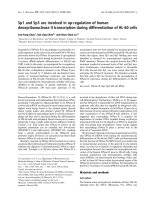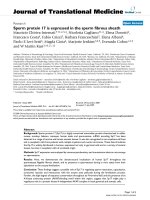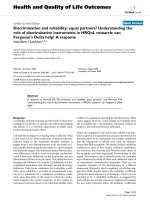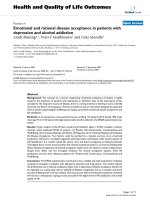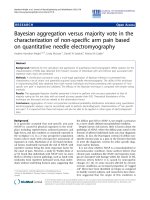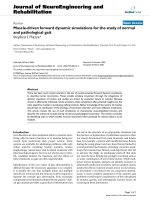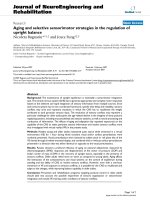báo cáo hóa học: " Aging and selective sensorimotor strategies in the regulation of upright balance" docx
Bạn đang xem bản rút gọn của tài liệu. Xem và tải ngay bản đầy đủ của tài liệu tại đây (571.67 KB, 7 trang )
BioMed Central
Page 1 of 7
(page number not for citation purposes)
Journal of NeuroEngineering and
Rehabilitation
Open Access
Research
Aging and selective sensorimotor strategies in the regulation of
upright balance
Nicoleta Bugnariu*
†1,2
and Joyce Fung
†2,3
Address:
1
School of Rehabilitation Sciences, University of Ottawa, 451 Smyth Road, Room 3057, Ottawa, Ontario, K1H 8M5, Canada,
2
Jewish
Rehabilitation Hospital CRIR Research Center, Laval, QC, H7V 1R2, Canada and
3
School of Physical and Occupational Therapy, McGill University,
Montreal, QC, H3G 1Y5, Canada
Email: Nicoleta Bugnariu* - ; Joyce Fung -
* Corresponding author †Equal contributors
Abstract
Background: The maintenance of upright equilibrium is essentially a sensorimotor integration
task. The central nervous system (CNS) has to generate appropriate and complex motor responses
based on the selective and rapid integration of sensory information from multiple sources. Since
each sensory system has its own coordinate framework, specific time delay and reliability, sensory
conflicts may arise and represent situations in which the CNS has to recalibrate the weight
attributed to each particular sensory input. The resolution of sensory conflicts may represent a
particular challenge for older adults given the age-related decline in the integrity of many postural
regulating systems, including musculoskeletal and sensory systems, as well as neural processing and
conduction of information. The effects of aging and adaptation (by repeated exposures) on the
capability of the CNS to select pertinent sensory information and resolve sensory conflicts were
thus investigated with virtual reality (VR) in the present study.
Methods: Healthy young and older adults maintained quiet stance while immersed in a virtual
environment (VE) for 1 hour during which transient visual and/or surface perturbations were
randomly presented. Visual perturbations were induced by sudden pitch or roll plane tilts of the
VE viewed through a helmet-mounted display, and combined with or without surface perturbations
presented in a direction that was either identical or opposite to the visual perturbations.
Results: Results showed a profound influence of aging on postural adjustments measured by
electromyographic (EMG) responses and displacements of the center of pressure (COP) and
body's center of mass (COM) in the recovery of upright stance, especially in the presence of
sensory conflicts. Older adults relied more on vision as compared to young adults. Aging affects
the interaction of the somatosensory and visual systems on the control of equilibrium during
standing and the ability of CNS to resolve sensory conflicts. However, even with a one-hour
immersion in VE and exposure to sensory conflicts, it is possible for the CNS to recalibrate and
adapt to the changes, while improving balance capability in older adults.
Conclusion: Preventive and rehabilitation programs targeting postural control in older adults
should take into account the possible impairment of sensory organization or sensorimotor
integration and include VE training under conditions of sensory conflicts.
Published: 20 June 2007
Journal of NeuroEngineering and Rehabilitation 2007, 4:19 doi:10.1186/1743-0003-4-19
Received: 1 February 2007
Accepted: 20 June 2007
This article is available from: />© 2007 Bugnariu and Fung; licensee BioMed Central Ltd.
This is an Open Access article distributed under the terms of the Creative Commons Attribution License ( />),
which permits unrestricted use, distribution, and reproduction in any medium, provided the original work is properly cited.
Journal of NeuroEngineering and Rehabilitation 2007, 4:19 />Page 2 of 7
(page number not for citation purposes)
Background
The CNS processes information from multiple sensory
channels, and adapts to the environment by generating
task-specific and goal-directed movements. Unexpected
movement of a support surface elicits rapid, automatic
and coordinated postural responses that are triggered pri-
marily by somatosensory afferents [1-4]. These responses
are not merely segmental reflexes organized at the level of
the spinal cord, but rather depend on the integration of
proprioceptive, visual and vestibular information at many
levels of the neuraxis [5-7]. Head-based sensors are
mapped downwards from neck muscles to leg muscles,
whereas somatosensory afferents from the feet and legs
are mapped upwards to the trunk [8].
Visual inputs were once thought to be irrelevant to sudden
stance perturbations, since the sensation of motion
induced by moving visual fields has a relatively long
latency [9]. Subsequent experiments have shown that vis-
ual information that conflicts with those arising from
other sensory channels can have a rapid and profound
effect on postural responses [10,11]. The influence of
moving visual fields on postural stability depends on the
characteristics of the visual environment, and of the sup-
port surface, including the size of the base of support, its
rigidity or compliance [12,13]. Within physiological lim-
its, a central recalibration process exists to produce appro-
priate responses even in the presence of sensory conflicts,
i.e. when visual perception of the environment is discord-
ant with proprioceptive information gathered from the
support surface. Aging is associated with the decline in the
integrity of many postural regulating systems [14-16], but
its effect on the sensory inputs recalibration process
remains to be determined. One question of interest is
whether selective sensorimotor strategies necessary to
maintain balance in the presence of sensory conflicts can
be entrained.
There is a need for intense task-related practice to promote
the re-acquisition of motor skills in rehabilitation. Virtual
reality (VR) is a valuable tool for therapeutic interventions
that require adaptation to complex, multimodal environ-
ments [13]. VR systems have been applied to the training
of upper and lower extremities after stroke [17,18], to
improve mobility in persons with impaired spatial abili-
ties or to train balance control [19,20] and in vestibular
rehabilitation [21]. Thus, the aim of the present study was
to determine the effects of aging and repeated exposures
on the capability of the CNS to select pertinent sensory
information and resolve sensory conflicts created by VR.
Methods
Subjects
Ten young adults (5 males and 5 females of mean age 26
± 5.1 y.o.) and 10 older adults (5 males and 5 females of
mean age 72 ± 3.3 y.o.) participated in this study. Subjects
were healthy with no neurological problems, muscu-
loskeletal conditions or motion sickness. Informed con-
sent to participate in the experiment previously approved
by the institutional ethics committee was obtained from
all subjects.
Procedure
During quiet stance, subjects were exposed to random vis-
ual and/or surface perturbations consisting of ramp-and-
hold tilts of 8° (peak velocity of 36°/s) in each direction
of the pitch and roll planes. Visual perturbations were
induced by sudden movements of a virtual environment
(VE) viewed through a helmet-mounted display (HMD,
Kaiser Optics ProView™ XL50, with a field of view of 50°
diagonal, 30° vertical × 40° horizontal, weight 36
ounces). The VE consisted of a 3D rendered computer-
simulated room generated by SoftImage XSI on a CAREN
2.3.0 Workstation (Motek Inc) and complete with win-
dows, columns, flooring and ceiling textures. The pertur-
bations consisted of: 1) visual-only, the VE was tilted but
the surface was stationary; 2) surface-only, the surface
was tilted but the VE was fixed; 3) discordant, visual per-
turbation was combined with synchronized surface per-
turbation in the same direction, and 4) concordant,
visual perturbation was combined with synchronized sur-
face perturbation in the opposite direction resembling the
real life perception.
The support surface was mounted over a six-degree-of-
freedom motion base servo-controlled by six electrohy-
draulic actuators [22]. The initial stance posture consisted
of weight evenly distributed between feet placed on 2
force-plates (AMTI OR6-7), heels 15 cm apart and feet ori-
ented in a 15° toe-out position. Subjects were instructed
to maintain balance to the best of their abilities without
taking steps where possible. If a step was taken, the sub-
jects were instructed to resume the initial stance posture.
A total of 72 perturbation trials were completed for a min-
imum of 1 hour VE immersion.
Data recording
A six-camera VICON 512 system (Oxford Metrics) was
used to capture 3D position data at 120 Hz from 36 retro-
reflective markers placed over anatomical landmarks and
4 markers placed on the movable platform. Ground reac-
tion forces and moments from the force-plates were
acquired at 1,080 Hz.
Eight bilateral muscles were instrumented with bipolar
Ag-AgCl surface electrodes to record electromyographic
(EMG) signals using a Noraxon system: tibialis anterior
(TA), gastrocnemius medialis (MG), vastus lateralis (VL),
semitendinosus (ST), tensor fascia latae (TFL), erector
spinae (ES) at the L3 level, neck extensor (NE) and neck
Journal of NeuroEngineering and Rehabilitation 2007, 4:19 />Page 3 of 7
(page number not for citation purposes)
flexor sternocleidomastoideus (SCM). EMG signals were
amplified, digitized, band-pass filtered (10–400 Hz low-
pass) and sampled at 1,080 Hz. EMG signals were further
full-wave rectified and lowpass filtered at 100 Hz during
offline analysis. Functional balance and mobility in terms
of gait velocity, ability to maintain tandem stance, timed
repeated sit-to-stand, as described in a physical perform-
ance battery [23] were assessed before and after VE expo-
sure and perturbation trials.
Data analysis
A biomechanical model (Plug-In Gait) was used in con-
junction with kinematic data and anthropometric meas-
ures to calculate the displacement of the body's center of
mass (COM). Resultant center of pressure (COP) in the
horizontal plane was calculated as the weighted sums
from the vertical force and anteroposterior (A/P) and
mediolateral (M/L) moments from the individual force
plate as described previously [24]. Inertial components in
forces and COP data due to movement of the support sur-
face were corrected [25]. Muscle latencies were deter-
mined as the first burst that exceeded a threshold of two
standard deviations above the background mean level and
lasting at least 50 ms, with an activation probability of at
least 50%. Data from different trials of each individual
were ensemble-averaged across each one of the four test-
ing conditions (vision only, surface only, discordant and
concordant) and each one of the directions of pitch (toes-
up/down) and tilt (left/right-down). These averages were
pooled to produce a population average (young and old)
for each direction of perturbations and condition of test-
ing. To estimate the ability to adapt, average responses
from the first 10 and last 10 trials were also calculated and
compared.
Results
Kinematics
Representative examples of COP and COM traces (thin
and thick lines, respectively, left-sided graphs), as well as
group averages of COM (right-sided bar graphs) during
pitch and roll perturbations are shown in Figures 1 and 2,
respectively. During visual-only perturbations, minimal
displacements of COP and COM were observed in both
subject groups. Surface perturbations, with or without vis-
ual perturbations, provoked displacements of COP and
COM first in the direction of the perturbation, and then
reversed to oppose the perturbation for balance adjust-
ment. Changes in COP always preceded and encompassed
those of COM. In young adults, COP and COM displace-
ments were smallest during perturbation where the visual
and somatosensory stimuli were concordant. The dis-
placements were markedly larger in older adults and took
longer duration to return to the neutral positions. In older
adults, during surface-only and discordant perturba-
tions, COM and COP excursions increased substantially
and took longer or never return to a neutral or stable posi-
tion.
During visual-only perturbations, similar and minimal
(2–10 mm) postural sway was observed in both the young
(gray) and old (black) groups of subjects (bar graphs, Fig-
ures 1 and 2). In general, across all other conditions of
testing, older adults displayed significantly larger COM
peak-to-peak excursions (20 to 40 mm more than young
adults). The presence of sensory conflicts in discordant
perturbations, and to a certain extent, surface-only pertur-
Pitch plane COP and COM responses in different sensory conditionsFigure 1
Pitch plane COP and COM responses in different
sensory conditions. Representative example of individual
traces of COP (thin lines) and COM (thick lines) from one
young and one old subject (left panel) exposed to toes-up tilt
of the surface. Bar graphs on the right panel show COM
peak-to-peak excursions (mean ± S.D.) averaged across 10
young subjects (gray bars) and 10 older subjects (black bars)
in both toes-up (left column) and toes-down (right column)
directions.
Journal of NeuroEngineering and Rehabilitation 2007, 4:19 />Page 4 of 7
(page number not for citation purposes)
bations, induced significantly larger COM excursions than
concordant perturbations in both young and old adults.
However, the presence of sensory conflicts required a
larger correction in older adults. During surface-only per-
turbations, mean COM excursions for older subjects com-
pared to young were 10–15 mm larger in pitch (Figure 1)
and 15–25 mm in roll (Figure 2) perturbations. During
conditions of discordant perturbations, COM excursions
were 30–50 mm and 20–40 mm larger in old subjects
compared to young during pitch (Figure 1) and roll (Fig-
ure 2) perturbations. During conditions of concordant
perturbations, COM excursions were not significantly dif-
ferent between old and young subjects. The average COP
values (not shown) displayed similar trends, although
always larger in range as compared to the COM.
EMG activity
The average EMG latencies of ventral muscles responding
in the toes-up pitch direction during surface-only, dis-
cordant and concordant perturbations in young and old
adults are shown in Figure 3. Young subjects showed sim-
ilar latencies from the first 10 to the last 10 trials, and thus
are averaged across all trials of similar conditions (Figure
3, gray circles). Old subjects showed increasingly earlier
activations from the first 10 (Figure 3, black diamonds) to
the last 10 trials (Figure 3, open triangles). No muscle acti-
vation was observed in young adults during visual-only
perturbations. In old adults, sporadic muscles activations
were present during visual-only perturbation but the acti-
vation probability of 50% was not reached, and thus were
not included further in the analysis. In young adults, mus-
cle recruitment generally followed a distal-to-proximal
sequence, regardless of perturbation direction or sensory
conflicts. The ankle muscles, TA and MG, were first to be
activated during toes-up and toes-down tilt, respectively,
at a latency of 80–100 ms. VL and ST were activated 110–
130 ms, followed by TFL and ES approximately 30–50 ms
later, while the neck muscles SCM and NE were activated
at 150–170 ms.
In older adults, the distal-to-proximal sequence of EMG
activation was less consistent, especially under sensory
conflicts, during surface-only and discordant perturba-
tions (Figure 3, black diamonds), where a reverse
sequence was observed. In some older subjects, following
discordant visual and somatosensory stimuli, activation
of neck muscles preceded distal leg muscles by 25–70 ms.
Generally, the EMG onset latencies of older adults, which
were already delayed as compared to young adults, were
further prolonged by 40–60 ms in conditions of sensory
conflicts. However, adaptation occurred during the one-
hour session such that ankle EMG latencies (Figure 3,
open triangles) were 20 ms shorter in the last 10/72 per-
turbations as compared to the first 10 trials.
Clinical measures
The average number of steps taken by older subjects also
decreased from 3 during the first 10 trials to one in the last
10 trials. At the end of the 1 h immersion in the VE and
repeated exposures to sensory conflicts perturbations,
four old adults scored 1–2 points higher on their ability to
maintain tandem stance. No change was observed in gait
speed and timed repeated sit-to-stand. All subjects toler-
ated well the use of the HMD with the exception of one
older subject who reported mild discomfort due to the
Roll plane COP and COM responses in different sensory conditionsFigure 2
Roll plane COP and COM responses in different sen-
sory conditions. Representative example of individual
traces of COP (thin lines) and COM (thick lines) from one
young and one old subject (left panel) exposed to right-down
roll of the surface. Bar graphs on the right panel show COM
peak-to-peak excursions (mean ± S.D.) averaged across 10
young subjects (gray bars) and 10 older subjects (black bars)
in both left-down (left column) and right-down roll (right col-
umn) directions.
Journal of NeuroEngineering and Rehabilitation 2007, 4:19 />Page 5 of 7
(page number not for citation purposes)
tight fitting. All subjects were able to complete the 1 h
immersion in the VE with no reports of nausea.
Discussion
Conflicting visual and somatosensory stimuli modulate
automatic postural responses in both healthy young and
old adults but the presence of sensory conflicts had a
larger impact on the selection of appropriate strategies for
balance control in older adults. When the VE was manip-
ulated to provide distorted visual perception, i.e. during
surface-only or discordant perturbations, older adults
took more steps, had longer EMG onset latencies as well
as larger COP and COM excursions. Postural instability as
measured by COM excursions increase markedly espe-
cially during discordant perturbations. Similar age-related
postural instability was also reported by Mahboobin et al.
[26] who showed that optic flow induced larger postural
responses in old subjects than in subjects who had
adapted from unilateral loss of vestibular function. It is
plausible that delayed or diminished vestibular and som-
atosensory inputs in older adults increases their sensory
thresholds to complex multimodal stimuli, thereby
inducing a greater reliance on visual inputs and making it
more difficult for them to respond selectively to visual
and physical destabilization. Excessive reliance on visual
input may be a natural compensatory strategy to cope
with poor balance in seniors, but it can be problematic
when the visual information is not reliable.
Visual-only perturbations elicit minimal postural
responses in both young and old subjects with only spo-
radic activations of muscles in older adults, suggesting
that under normal circumstances when there is a stable
support surface, the somatosensory information is
weighted more in regulating upright posture. The use of
HMD to deliver the visual perturbation might have also
limited the influence of visual inputs. Postural responses
coupled with optic flow are less frequent when the optic
flow is delivered in a central field of view, like the HMD,
as compared to BNAVE display with a full field of view
[21,27]. The influence of moving visual fields on postural
stability depends on the characteristics not only of the vis-
ual environment, static vs. dynamic [28], but also of the
support surface. Somatosensory information from the
lower extremities and trunk is particularly important for
maintaining balance when the subject maintains contact
with a large, rigid, and stable support surface [7]. In such
conditions, quiet stance is usually not destabilized by
moving the visual field, except for children who are more
visually dependent [29]. In contrast, surface-only pertur-
bations present a postural challenge for both young and
old. EMG onset latencies can be delayed and prolonged,
while postural sway increases, as compared to concordant
visual and somatosensory perturbations. Similar effects of
Single-session adaptation of muscle responsesFigure 3
Single-session adaptation of muscle responses. EMG
latencies (mean ± S.D.) of ventral muscles responding to
toes-up pitch surface perturbations across young (gray cir-
cles) and old subjects. Note the decrease in the latencies in
old subjects from the first 10 (black diamonds) to the last 10
(open triangles) trials.
Journal of NeuroEngineering and Rehabilitation 2007, 4:19 />Page 6 of 7
(page number not for citation purposes)
visual stabilization were observed on initial bursts of
ankle muscles [11].
Discordant perturbations are most challenging with long-
est onset latencies of neck muscles observed in young
adults, suggesting that they deal with the mismatch in vis-
ual and somatosensory information by either attempting
to suppress visual information altogether, or re-weight
proprioceptive feedback with increasing reliance. Older
adults adopted a completely opposite strategy by activat-
ing the neck muscles first, suggesting an excessive reliance
on visual inputs or the need to for head stabilization.
With repeated exposures to VR-induced sensory conflicts,
a general training effect associated with less stepping
responses and improved ability to maintain balance was
observed in older adults. The ability to anticipate the
physical constraints of the environment and adapt the
balance behaviour accordingly is the result of intricate
sensorimotor integration. The cognitive processes range
from correctly perceiving and interpreting information
from different body sensors (somatosensory, vestibular
and visual) to planning and coordinating the effectors
appropriately to produce the desired movement. Motor
learning is promoted by factors such as changing environ-
mental contexts, alterations in the physical demands,
problem solving, and random presentation of practice
tasks, sufficient practice and patient empowerment [30].
Even with a one-hour immersion in VE and exposure to
sensory conflicts, it seems possible for the CNS to recali-
brate and adapt to the changes and improve balance capa-
bility in older adults. A training program of longer
durations is needed to confirm sustainable long-term
effects. Preventive and rehabilitation programs targeting
postural control in older adults should take into account
the possible impairment of sensory organization or senso-
rimotor integration, and consider VE training under con-
ditions of sensory conflicts as a potential rehabilitation
strategy.
Conclusion
Conflicting visual and somatosensory stimuli can modu-
late automatic postural responses in both healthy young
and old adults. Aging affects the interaction of the soma-
tosensory and visual systems on the ability of the CNS to
resolve sensory conflicts and to maintain upright stance
equilibrium. Therefore, rehabilitation programs targeting
postural control in seniors should take into account the
possible impairment of sensory organization and con-
sider the inclusion of exercises performed under condi-
tions of sensory conflicts.
Competing interests
The author(s) declare that they have no competing inter-
ests.
Authors' contributions
NB has been involved in the conception and design, data
acquisition, analysis and interpretation, as well as drafting
the manuscript. JF participated in the design of the study
and data interpretation, and critically revised the manu-
script for its intellectual content. Both authors have read
and approved the final manuscript.
Acknowledgements
This work was supported in part by the Canadian Institutes of Health
Research and the Jewish Rehabilitation Hospital (JRH) Foundation. Nicoleta
Bugnariu was funded by a Tomlinson postdoctoral research fellowship
award at McGill University. Joyce Fung is a William Dawson Scholar at the
School of Physical and Occupational Therapy, McGill University and senior
research fellow of the Fonds de la Recherché en Santé du Québec (FRSQ).
She is also the Director of Research at the JRH, a site of the Montreal
Research Center for Interdisciplinary Research in Rehabilitation (CRIR).
The authors would like to thank all participants, as well as Christian Beau-
doin, Luncinda Hughey, Eric Johnstone and Erika Hasler for their skilful help
and assistance.
References
1. Diener HC, Horak FB, Nashner LM: Influence of stimulus param-
eters on human postural responses. J Neurophysiol 1988,
59:1888-1905.
2. Inglis T, Macpherson JM: Bilateral labrynthectomy in the cat:
effects on postural response to translation. J Neurophysiol 1995,
73:1181-1191.
3. Runge CF, Shupert CL, Horak FB, Zajac FE: Role of vestibular
information in initiation of rapid postural responses. Exp Brain
Res 1998, 122:403-412.
4. Fung J, Hughey L: Postural responses triggered by multidirec-
tional leg litfs and surface tilts. Exp Brain Res 2005, 165:152-166.
5. Fung J, Macpherson JM: Attributes of quiet stance in the chronic
spinal cat. J Neurphysiol 1999, 82(6):3056-3065.
6. Macpherson JM, Fung J: Weight support and balance during
stance in the chronic spinal cat. J Neurophysiol 1999,
82:3066-3081.
7. Horak FB, Macpherson JM: Postural orientation and equilib-
rium. Handbook of Physiology: Section 12: Integration of Motor, Circula-
tory, Respiratory and Metabolic control during Exercises. New York
1996:22-46.
8. Mergner T, Huber W, Becker W: Vestibular-neck interaction
and transformation of sensory coordinates. J Vestib Res 1997,
7(4):347-67.
9. Nashner L, Berthoz A: Visual contribution to rapid motor
responses during postural control. Brain Res 1978,
150(2):403-7.
10. Vidal PP, Berthoz A, Millanvoye M: Difference between eye clo-
sure and visual stabilization in the control of posture in man.
Aviat Space Environ Med 1982, 53(2):166-70.
11. Keshner EA, Kenyon RV, Langston J: Postural responses exhibit
multisensory dependencies with discordant visual and sup-
port surface motion. J Vestib Res 2004, 14(4):307-19.
12. Streepey JW, Kenyon RV, Keshner EA: Field of view and base of
support width influence postural responses to visual stimuli
during quiet stance. Gait Posture 2006, 25(1):49-55.
13. Keshner EA, Kenyon RV: Using immersive technology for pos-
tural research and rehabilitation. Assistive Technology 2004,
16(1):54-62.
14. Horak F, Shupert C, Mirka A: Components of postural dyscon-
trol in the elderly: a review. Neurobiol Aging 1989, 10:727-745.
15. Manchester D, Woollacott M, Zederbauer-Hylton N, Marin O: Vis-
ual, vestibular and somatosensory contributions to balance
control in the older adult. J Gerontol 1989, 44:M118-M127.
16. Maki BE, McIlroy WE: Postural control in the older adult. Clin
Geriatr Med 1996, 12:635-658.
Publish with BioMed Central and every
scientist can read your work free of charge
"BioMed Central will be the most significant development for
disseminating the results of biomedical research in our lifetime."
Sir Paul Nurse, Cancer Research UK
Your research papers will be:
available free of charge to the entire biomedical community
peer reviewed and published immediately upon acceptance
cited in PubMed and archived on PubMed Central
yours — you keep the copyright
Submit your manuscript here:
/>BioMedcentral
Journal of NeuroEngineering and Rehabilitation 2007, 4:19 />Page 7 of 7
(page number not for citation purposes)
17. Holden M, Todorov E, Callaban J, Bizzi E: Virtual environment
training improves motor performance in two patients with
stroke. Neurology Report 1999, 23:57-67.
18. Deutsch JE, Latonio J, Burdca GC, Boian R: Post-stroke rehabilita-
tion with Rutgers ankle system A case study. Presence 2001,
10:416-430.
19. McComas J, Sveistrup H: Virtual reality application for preven-
tion, disability awareness and physical therapy rehabilitation
in neurology: our recent work. Neurol Report 2002, 26:55-61.
20. Sveistrup H: Motor rehabilitation using virtual reality. J Neuro-
engineering Rehabil 2004, 1(1):10.
21. Whitney SL, Sparto PJ, Brown K, Furman JM, Jacobson JL, Redfern MS:
The potential use of virtual reality in vestibular rehabilita-
tion: Preliminary findings with the BNAVE. Neurology Report
2002, 26:72-78.
22. Henry S, Fung J, Horak FB: Control of stance during lateral and
anterior/posterior surface translations. IEEE Trans Rehab Eng
1998, 6(1):32-34.
23. Fung J, Johnstone E: Lost in space. Multi-axial and multi-dimen-
sional surface perturbations delivered by a novel motion
base device [abstract]. Soc Neurosci 1998, 24(1):1158.
24. Guralnik JM, Ferrucci L, Pieper CF: Lower extremity function and
subsequent disability: consistency across studies, predictive
models, and value of gait speed alone compared with the
short physical performance battery. J Gerontol A Biol Sci Med Sci
2000, 55(4):M221-M231.
25. Preuss R, Fung J: A simple model to estimate force plate iner-
tial components in a moving surface. J Biomechanics 2004,
37:1177-1180.
26. Mahboobin A, Loughlin PJ, Redfern MS, Sparto PJ: Sensory re-
weighting in human postural control during moving-scene
perturbations. Exp Brain Res 2005, 167(2):260-7.
27. Sparto PJ, Redfern MS, Jasko JG, Casselbrant ML, Mandel EM, Furman
JM: The influence of dynamic visual cues for postural control
in children aged 7–12 years. Exp Brain Res 2006, 168(4):505-16.
28. Amblard B, Cremieux J, Marchand AR, Carblanc A: Lateral orienta-
tion and stabilization of human stance: static versus dynamic
visual cues. Exp Brain Res 1985, 61(1):21-37.
29. Woollacott M, Sveistrup H: Changes in the sequencing and tim-
ing of muscle response coordination associated with devel-
opmental transitions in balance abilities. Human Movement Sci
1992, 11:23-36.
30. Winstein CJ: Knowledge of the results and motor learning:
implications for physical therapy. Physical Therapy 1991,
71:140-149.
